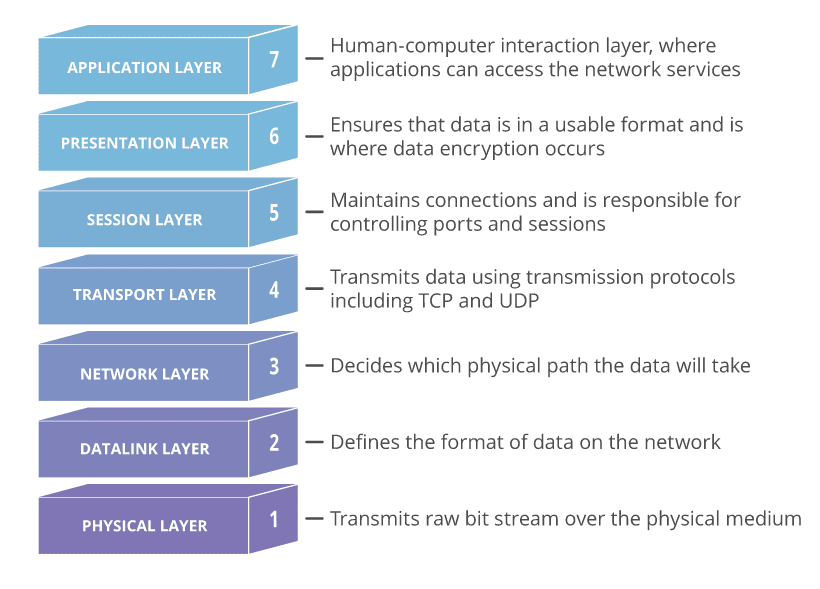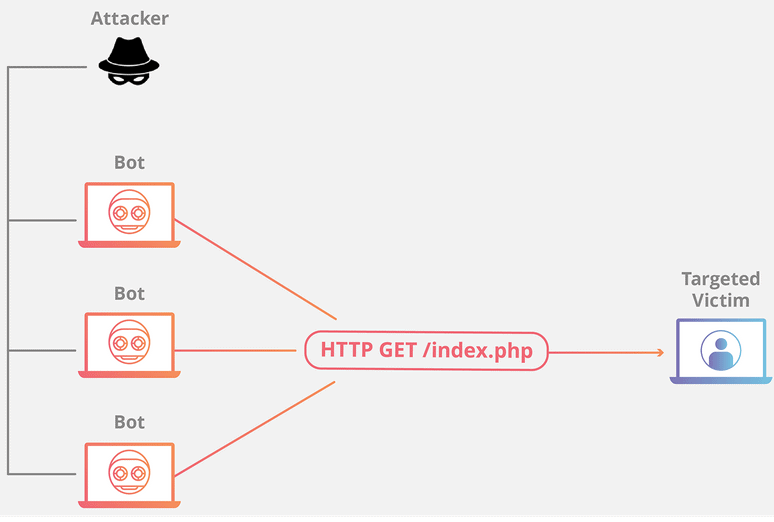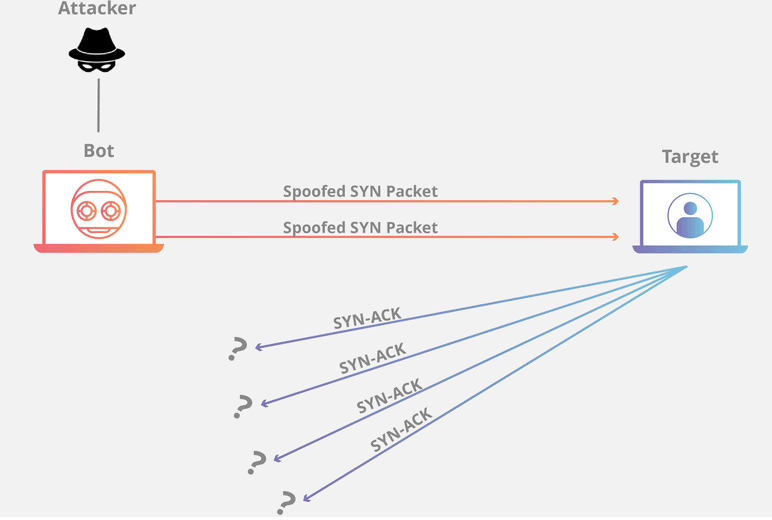Distributed denial-of-service
What is a distributed denial of service attack (DDoS)?
Security+ Objectives
A denial-of-service (DoS) attack occurs when legitimate users are unable to access information systems, devices, or other network resources due to the actions of a malicious cyber threat actor. Services affected may include email, websites, online accounts (e.g., banking), or other services that rely on the affected computer or network. A denial-of-service condition is accomplished by flooding the targeted host or network with traffic until the target cannot respond or simply crashes, preventing access for legitimate users. DoS attacks can cost an organization both time and money while their resources and services are inaccessible.
Network
Different types of DDoS attacks target varying components of a network connection. In order to understand how different DDoS attacks work, it is necessary to know how a network connection is made.
A network connection on the Internet is composed of many different components or “layers”. Like building a house from the ground up, each layer in the model has a different purpose.
The OSI Model, shown below, is a conceptual framework used to describe network connectivity in 7 distinct layers.

While nearly all DDoS attacks involve overwhelming a target device or network with traffic, attacks can be divided into three categories. An attacker may use one or more different attack vectors, or cycle attack vectors in response to counter measures taken by the target.
Application Layer
The goal of the attack:
Sometimes referred to as a layer 7 DDoS attack (in reference to the 7th layer of the OSI model), the goal of these attacks is to exhaust the target’s resources to create a denial-of-service.
The attacks target the layer where web pages are generated on the server and delivered in response to HTTP requests. A single HTTP request is computationally cheap to execute on the client side, but it can be expensive for the target server to respond to, as the server often loads multiple files and runs database queries in order to create a web page.
Layer 7 attacks are difficult to defend against, since it can be hard to differentiate malicious traffic from legitimate traffic.
Application Layer Attack Examples
– HTTP Flood
This attack is similar to pressing refresh in a web browser over and over on many different computers at once – large numbers of HTTP requests flood the server, resulting in denial-of-service.
This type of attack ranges from simple to complex.
Simpler implementations may access one URL with the same range of attacking IP addresses, referrers and user agents. Complex versions may use a large number of attacking IP addresses, and target random urls using random referrers and user agents.

– Protocol Attacks
The goal of the attack:
Protocol attacks, also known as a state-exhaustion attacks, cause a service disruption by over-consuming server resources and/or the resources of network equipment like firewalls and load balancers.
Protocol attacks utilize weaknesses in layer 3 and layer 4 of the protocol stack to render the target inaccessible.

– Volumetric Attacks
The goal of the attack:
This category of attacks attempts to create congestion by consuming all available bandwidth between the target and the larger Internet. Large amounts of data are sent to a target by using a form of amplification or another means of creating massive traffic, such as requests from a botnet.
– DNS Amplification
A DNS amplification is like if someone were to call a restaurant and say “I’ll have one of everything, please call me back and repeat my whole order,” where the callback number actually belongs to the victim. With very little effort, a long response is generated and sent to the victim.
By making a request to an open DNS server with a spoofed IP address (the IP address of the victim), the target IP address then receives a response from the server.

How to Defend Against DDoS Attacks
– Mitigation
Mitigation refers to the methods and techniques put in place in order to reduce the negative effects on a server or service targeted by a DDoS attack. Mitigation consists of filtering traffic, so that only legitimate traffic reaches the server.
– Attack Detection
The first step of any mitigation strategy is understanding when you are the target of a DoS attack. Analyzing incoming traffic and determining whether or not it’s legitimate is the first step in keeping your service available and responsive. Scalable cloud service providers are great (and may even “absorb” a DoS attack transparently) which is fantastic until you receive an enormous bill for bandwidth or resource overuse. Making sure your cloud provider makes scaling decisions based only on legitimate traffic is the best way to ensure your company is not spending unnecessary elasticity dollars due to an attack. Early detection of an attack dramatically increases the efficacy of any mitigation strategy.
– Blackhole Routing
One solution available to virtually all network admins is to create a blackhole route and funnel traffic into that route. In its simplest form, when blackhole filtering is implemented without specific restriction
criteria, both legitimate and malicious network traffic is routed to a null route, or blackhole, and dropped from the network.
If an Internet property is experiencing a DDoS attack, the property’s Internet service provider (ISP) may send all the site’s traffic into a blackhole as a defense. This is not an ideal solution, as it effectively gives the attacker their desired goal: it makes the network inaccessible.
– Rate Limiting
Rate limiting is the practice of limiting the amount of traffic available to a specific Network Interface Controller (NIC). It can be done at the hardware or software level to mitigate the chances of falling victim to a DoS attack. At the hardware level, switches and routers usually have some degree of rate-limiting capabilities. At the software level, it’s essential to have a limit on the number of concurrent calls available to a specific customer. Giving users strictly defined limits on concurrent requests or total requests over a given duration (50 requests per minute) can be an excellent way to reject traffic and maintain service stability. The rate limit is usually tied to the customer’s plan or payment level. For example, customers on a free plan may only get 1,000 API calls, whereas customers at the premium level may get 10,000 API calls. Once the user reaches their rate limit, the service returns an HTTP status code indicating “too many requests” (status code 429).
While rate limiting is useful, depending on it alone is not enough. Using a router’s rate limiting features means that requests will still reach the router. Even the best routers can be overwhelmed and DoSed. At the software level, requests still need to reach your service even if a rate-limit has been reached to serve up a 429 status code. This means that your service could still be overwhelmed by requests, even if your service is only returning an error status code.
– Web Application Firewall
A Web Application Firewall (WAF) is a tool that can assist in mitigating a layer 7 DDoS attack. By putting a WAF between the Internet and an origin server, the WAF may act as a reverse proxy, protecting the targeted server from certain types of malicious traffic.
By filtering requests based on a series of rules used to identify DDoS tools, layer 7 attacks can be impeded. One key value of an effective WAF is the ability to quickly implement custom rules in response to an attack.
– Upstream Filtering and DDS
One of the best mitigation strategies is to filter requests upstream, long before it reaches the target network. Done effectively, your API never even sees this traffic, so any rate limiting policies are not triggered. There are many providers of “Mitigation Centers” that will filter the incoming network traffic. For example Amazon Shield (opens new window) and Cloudflare (opens new window) both offer products that allow for protection against DoS and DDoS attacks by checking incoming packet IPs against known attackers and BotNets and attempt to only forward legitimate traffic. Various API gateways have the same capabilities but can also filter based on the requested endpoint, allowed HTTP verbs, or even a combination of verbs and endpoints.
These companies typically offer support should your service be currently under attack in an attempt to minimize damages. It then becomes the responsibility of the provider to keep abreast of new DDoS attack vectors and strategies, leaving you to focus on building your service.
Sources: Cloudflare, CISA, Norton, Akamai
Are you looking to break into the exciting field of cybersecurity? Join our 5-day CompTIA Security+ Bootcamp Training and build your cybersecurity knowledge and skills.
Or
Become a certified ethical hacker! Our 5-day CEH Bootcamp is unlike other strictly theoretical training, you will be immersed in interactive sessions with hands-on labs after each topic. You can explore your newly gained knowledge right away in your classroom by pentesting, hacking and securing your own systems. Learn more






